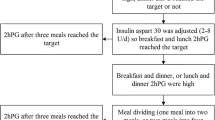Summary
The effect of a subcutaneous injection of an intermediate-acting insulin at bedtime combined with glibenclamide has been evaluated in 16 non-insulin-diabetic patients with secondary failure to respond to oral agents.
The patients showed poor metabolic control (HbA1>11%) after two months on diet and glibenclamide treatment (15 mg.day−1). For 3 months the glibenclamide was continued together with an injection of an intermediate-acting insulin at bedtime in order to maintain fasting blood glucose under 120 mg.dl−1. A significant reduction in fasting blood glucose and HbA1 (15.50 vs 10.35%) and fructosamine (2.03 vs 1.69 mmol.l−1) was observed (230 to 141 mg.dl−1) at a mean insulin dose of 0.28 U.kg−1. The peak blood glucose after a standard test meal was also significantly improved (290 vs 203 mg.dl−1).
Two months after the bedtime insulin injection had been withdrawn, only one patient was still being treated with oral agents alone. Except for another patient who dropped out, all the others had to be treated again with insulin because their fasting blood glucose exceeded 180 mg.dl−1.
It is concluded that a single subcutaneous injection of an intermediate-acting insulin at bedtime combined with glibenclamide improved fasting and post-meal blood glucose concentrations in non-insulin-dependent patients resistant to diet and oral hypoglycaemic treatment. Almost all of the patients relapsed after insulin was withdrawn.
Similar content being viewed by others
References
DeFronzo RA (1988) The triumvirate: beta-cell, muscle, liver. Collusion responsible for NIDDM. Diabetes 37: 667–668
DeFronzo RA, Deibert D, Hendler R, Felig P (1982) Insulin sensitivity and insulin binding to monocytes in maturity-onset diabetes. J Clin Invest 63: 939–946
Unger RH, Grundy S (1989) Hyperglycemia as an inducer as well as a consequence of impaired islet cell function and insulin resistance implication for the management of diabetes. Diabetol 28: 119–121
Rosseti L, Smith D, Shulman GI, Papachristou D, DeFronzo RA (1987) Correction of hyperglycemia with phlorizin normalizes tissue sensitivity to insulin in diabetic rats. J Clin Invest 79: 1510–1515
Robertson RP, Porte D (1973) The glucose receptor a detective mechanism in diabetes mellitus distinct from beta adrenergic receptor. J Clin Invest 52: 870–876
Riddle MC, Hart JS (1985) Which patients might benefit from combining a sulfonylurea with insulin? Diabetes Care 8: 204–206
Riddle MC (1985) Lancet I: 192–195
Riddle MC (1990) Evening insulin strategy. Diabetes Care 13: 676–686
Backer JR, Metcalf PA, Johnson RN, Newman D, Rietz P (1985) Use of protein-base standards in automated colorimetric determinations of fructosamine in serum. Clin Chem 31: 1550–1554
Allen T, Feinglos MN, Lebovitz HE (1985) Treatment of poorly regulated non-insulin-dependent diabetes mellitus with combination insulin-sulfonylurea. Arch Intern Med 145: 1900–1903
Rizza RA (1985) Combined sulfonylurea and insulin therapy in insulin-dependent diabetes: research of clinical practice? Diabetes Care 8: 511–514
Stenman S, Groop PH, Saloranta C, Totterman KJ, Fyhrqvist F, Groop L (1988) Effects of the combination of insulin and gliben-clamide in type 2 (non-insulin-dependent) diabetic patients with secondary failure to oral hypoglycaemic agents. Diabetol 31: 206–213
Gutniak M, Karlander SG, Effendic S (1987) Glyburide decreases insulin requirement, increases B-cell response to mixed meal, and does not affect insulin sensitivity: effects of short- and long-term combined treatment in secondary failure to sulfonylurea. Diabetes Care 10: 545–554
Schade DS, Mitchell WJ, Ganera Griego RN (1987) Addition of sulfonylurea to insulin treatment in poorly controlled type II diabetes. JAMA 257: 2441–2445
Olefsky JM (1985) Pathogenesis of insulin resistance and hyperglycemia in non-insulin-dependent diabetes mellitus. Am J Med 79: 1–7
Andrews WJ, Vasquez B, Nagulespran M (1984) Insulin therapy in obese, non-insulin-dependent diabetes induces improvements in insulin action and secretion that are maintained for two weeks after insulin withdrawal. Diabetes 33: 634–642
Turner RC, McCarthy ST, Holman RR, Harris E (1976) Beta-cell function improved by supplementing basal insulin secretion in mild diabetes. Br Med J 1 (6020): 1252–1254
Scarlett JA, Greg RS, Griffin J, Olefsky J, Kolterman OG (1982) Insulin treatment reverses the insulin resistance of type II diabetes mellitus. Diabetes Care 5: 353–363
Kolterman OG, Gray RS, Shapiro G, Scarlett JA, Griffin J, Olefsky JM (1984) The acute and chronic effects of sulfonylurea therapy in type II diabetic subjects. Diabetes 33: 346–354
Taskinen MR, Sane T, Helve E, Karonen SL, Nikkila EA, Yki-Jarvinen H (1989) Bedtime insulin for suppression of overnight free-fatty acid, blood glucose, and glucose production in NIDDM. Diabetes 38: 580–588
Trischitta V, Italia S, Borzi V, Tribulato A, Mazzarino S, Squatrito S, Vigneri R (1989) Low-dose bedtime NPH insulin in treatment of secondary failure to glyburide. Diabetes Care 12: 582–585
Prader R, Wallace P, Olefsky JM (1987) Direct and indirect effects of insulin to inhibit hepatic glucose output in obese subjects. Diabetes 36: 607–611
Seigler DE, Olsson M, Skyler JS (1987) Morning vs bedtime NPH insulin in type II (non-insulin-dependent) diabetes mellitus. Diabetol vn30: 518A
Groop L, Harno K, Tolppanen EM (1984) The combination of insulin and sulfonylurea in the treatment of secondary drug failure in patients with type II diabetes. Acta Endocrinol 106: 97–101
Groop L, Harno K, Nikkila EA, Pelkonen R, Tolppanen EM (1985) Transient effect of the combination of insulin and sulfonylurea (glibenclamide) on glycemic control in non-insulin-dependent diabetics poorly controlled with insulin alone. Acta Med Scand 217: 33–39
Kyllastinen M, Groop L (1985) Combination of insulin and glibenclamide in the treatment of elderly non-insulin-dependent (type 2) diabetic patients. Ann Clin Res 17: 100–104
Riddle MC, Hart JS, Bouma DJ, Phillipson BE, Youker G (1989) Efficacy of bedtime NPH insulin with daytime sulfonylurea for subpopulation of type II diabetic subjects. Diabetes Care 12: 623–629
Author information
Authors and Affiliations
Rights and permissions
About this article
Cite this article
Krempf, M., Godeau, T., Ranganathan, S. et al. Effects of a combination of bedtime intermediate-acting insulin and glibenclamide in type 2 (non-insulin-dependent) diabetic patients with secondary failure to respond to oral hypoglycaemic agents. Eur J Clin Pharmacol 42, 281–286 (1992). https://doi.org/10.1007/BF00266349
Issue Date:
DOI: https://doi.org/10.1007/BF00266349




